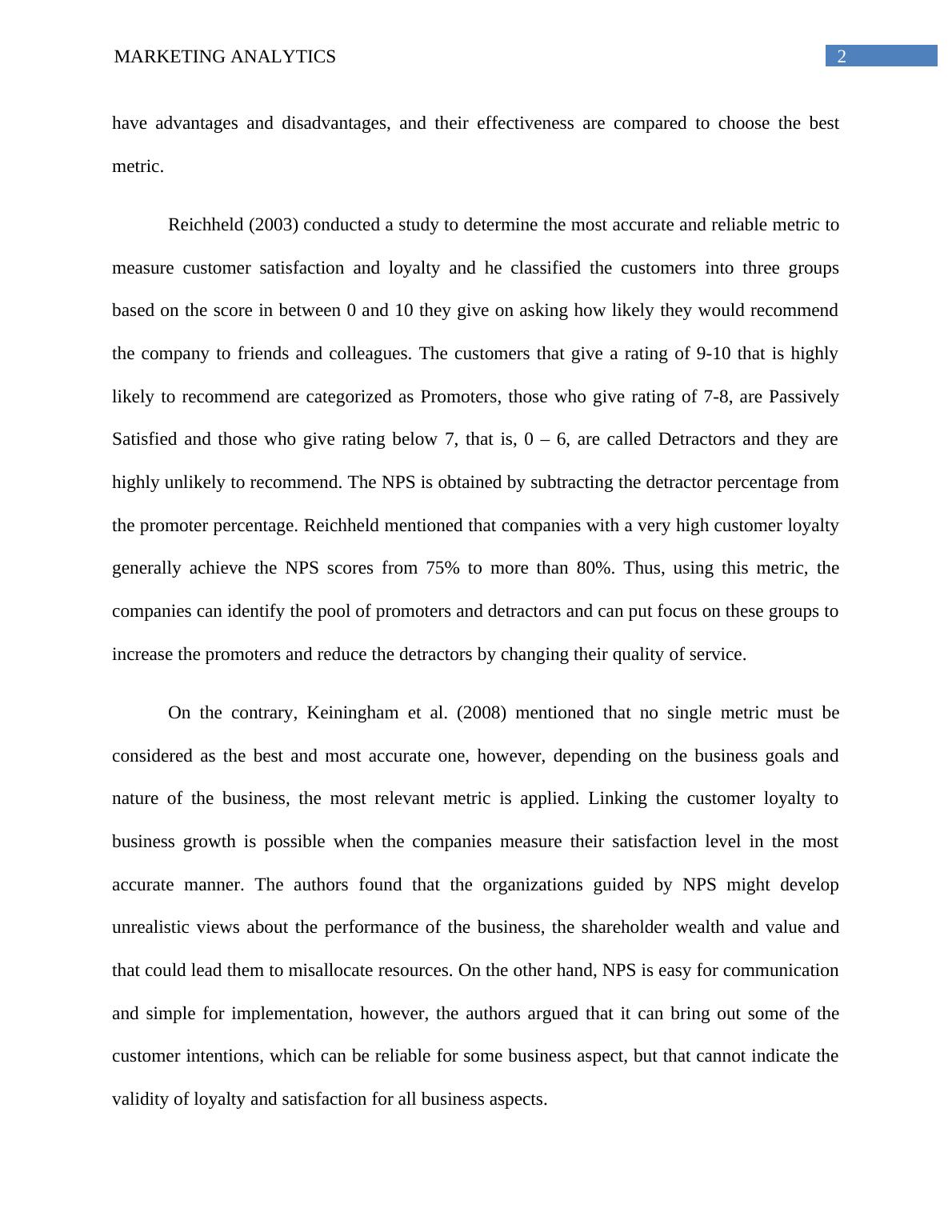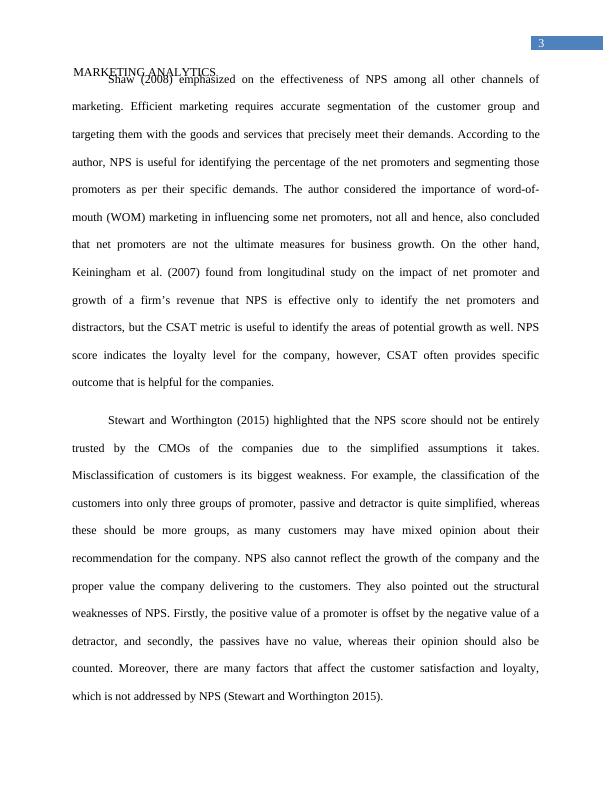THE MARKETING ANALYTICS
Added on 2022-09-09
12 Pages2538 Words21 Views
Running head: MARKETING ANALYTICS
Marketing Analytics
Name of the Student:
Name of the University:
Author note:
Marketing Analytics
Name of the Student:
Name of the University:
Author note:

1
MARKETING ANALYTICS
1. Introduction
The report aims to provide a comparative discussion on the effectiveness of Net Promoter
Score (NPS) and Customer Satisfaction Metric (CSAT) used in the major Australian banks for
quite some time now. Both NPS and Customer Satisfaction Metric are two important tools for
measuring the customer satisfaction level and are precise predictors of loyalty of the customers
and the lifetime value at a particular point in time (Eklof, Podkorytova and Malova 2018). These
scores are used for predicting change and current profitability of an organization, however, the
major difference between these two tools is the that the CSAT measures the short term loyalty,
while NPS measures the long term customer satisfaction and loyalty. Thus, for evaluating the
long term customer satisfaction level derived from personal banking experience, the Australian
banks are replacing their CSAT measurement system by NPS. This report will provide an
overview of customer responses on their experience from their banks and their loyalty level and
will reflect on the relative effectiveness of the two systems to help the CMO of National
Australia Bank (NAB), Jane Porter, to choose either NPS or existing CSAT system.
2. Existing knowledge, research, and/or views
Measuring customer satisfaction level and loyalty in extremely essential to understand
the position of an organization in the market and with this information the organization can take
measures to improve its brand value and image. Business success depends on its customer base
and it is important for a business to deliver highest level of customer satisfaction as a long term
goal, which turns into customer loyalty. Customer Satisfaction Metric (CSAT) and Net Promoter
Score (NPS) are two useful measures that help organizations to understand the customers’
perception about their services and their competitive position in the market. Both these measures
MARKETING ANALYTICS
1. Introduction
The report aims to provide a comparative discussion on the effectiveness of Net Promoter
Score (NPS) and Customer Satisfaction Metric (CSAT) used in the major Australian banks for
quite some time now. Both NPS and Customer Satisfaction Metric are two important tools for
measuring the customer satisfaction level and are precise predictors of loyalty of the customers
and the lifetime value at a particular point in time (Eklof, Podkorytova and Malova 2018). These
scores are used for predicting change and current profitability of an organization, however, the
major difference between these two tools is the that the CSAT measures the short term loyalty,
while NPS measures the long term customer satisfaction and loyalty. Thus, for evaluating the
long term customer satisfaction level derived from personal banking experience, the Australian
banks are replacing their CSAT measurement system by NPS. This report will provide an
overview of customer responses on their experience from their banks and their loyalty level and
will reflect on the relative effectiveness of the two systems to help the CMO of National
Australia Bank (NAB), Jane Porter, to choose either NPS or existing CSAT system.
2. Existing knowledge, research, and/or views
Measuring customer satisfaction level and loyalty in extremely essential to understand
the position of an organization in the market and with this information the organization can take
measures to improve its brand value and image. Business success depends on its customer base
and it is important for a business to deliver highest level of customer satisfaction as a long term
goal, which turns into customer loyalty. Customer Satisfaction Metric (CSAT) and Net Promoter
Score (NPS) are two useful measures that help organizations to understand the customers’
perception about their services and their competitive position in the market. Both these measures

2
MARKETING ANALYTICS
have advantages and disadvantages, and their effectiveness are compared to choose the best
metric.
Reichheld (2003) conducted a study to determine the most accurate and reliable metric to
measure customer satisfaction and loyalty and he classified the customers into three groups
based on the score in between 0 and 10 they give on asking how likely they would recommend
the company to friends and colleagues. The customers that give a rating of 9-10 that is highly
likely to recommend are categorized as Promoters, those who give rating of 7-8, are Passively
Satisfied and those who give rating below 7, that is, 0 – 6, are called Detractors and they are
highly unlikely to recommend. The NPS is obtained by subtracting the detractor percentage from
the promoter percentage. Reichheld mentioned that companies with a very high customer loyalty
generally achieve the NPS scores from 75% to more than 80%. Thus, using this metric, the
companies can identify the pool of promoters and detractors and can put focus on these groups to
increase the promoters and reduce the detractors by changing their quality of service.
On the contrary, Keiningham et al. (2008) mentioned that no single metric must be
considered as the best and most accurate one, however, depending on the business goals and
nature of the business, the most relevant metric is applied. Linking the customer loyalty to
business growth is possible when the companies measure their satisfaction level in the most
accurate manner. The authors found that the organizations guided by NPS might develop
unrealistic views about the performance of the business, the shareholder wealth and value and
that could lead them to misallocate resources. On the other hand, NPS is easy for communication
and simple for implementation, however, the authors argued that it can bring out some of the
customer intentions, which can be reliable for some business aspect, but that cannot indicate the
validity of loyalty and satisfaction for all business aspects.
MARKETING ANALYTICS
have advantages and disadvantages, and their effectiveness are compared to choose the best
metric.
Reichheld (2003) conducted a study to determine the most accurate and reliable metric to
measure customer satisfaction and loyalty and he classified the customers into three groups
based on the score in between 0 and 10 they give on asking how likely they would recommend
the company to friends and colleagues. The customers that give a rating of 9-10 that is highly
likely to recommend are categorized as Promoters, those who give rating of 7-8, are Passively
Satisfied and those who give rating below 7, that is, 0 – 6, are called Detractors and they are
highly unlikely to recommend. The NPS is obtained by subtracting the detractor percentage from
the promoter percentage. Reichheld mentioned that companies with a very high customer loyalty
generally achieve the NPS scores from 75% to more than 80%. Thus, using this metric, the
companies can identify the pool of promoters and detractors and can put focus on these groups to
increase the promoters and reduce the detractors by changing their quality of service.
On the contrary, Keiningham et al. (2008) mentioned that no single metric must be
considered as the best and most accurate one, however, depending on the business goals and
nature of the business, the most relevant metric is applied. Linking the customer loyalty to
business growth is possible when the companies measure their satisfaction level in the most
accurate manner. The authors found that the organizations guided by NPS might develop
unrealistic views about the performance of the business, the shareholder wealth and value and
that could lead them to misallocate resources. On the other hand, NPS is easy for communication
and simple for implementation, however, the authors argued that it can bring out some of the
customer intentions, which can be reliable for some business aspect, but that cannot indicate the
validity of loyalty and satisfaction for all business aspects.

3
MARKETING ANALYTICS
Shaw (2008) emphasized on the effectiveness of NPS among all other channels of
marketing. Efficient marketing requires accurate segmentation of the customer group and
targeting them with the goods and services that precisely meet their demands. According to the
author, NPS is useful for identifying the percentage of the net promoters and segmenting those
promoters as per their specific demands. The author considered the importance of word-of-
mouth (WOM) marketing in influencing some net promoters, not all and hence, also concluded
that net promoters are not the ultimate measures for business growth. On the other hand,
Keiningham et al. (2007) found from longitudinal study on the impact of net promoter and
growth of a firm’s revenue that NPS is effective only to identify the net promoters and
distractors, but the CSAT metric is useful to identify the areas of potential growth as well. NPS
score indicates the loyalty level for the company, however, CSAT often provides specific
outcome that is helpful for the companies.
Stewart and Worthington (2015) highlighted that the NPS score should not be entirely
trusted by the CMOs of the companies due to the simplified assumptions it takes.
Misclassification of customers is its biggest weakness. For example, the classification of the
customers into only three groups of promoter, passive and detractor is quite simplified, whereas
these should be more groups, as many customers may have mixed opinion about their
recommendation for the company. NPS also cannot reflect the growth of the company and the
proper value the company delivering to the customers. They also pointed out the structural
weaknesses of NPS. Firstly, the positive value of a promoter is offset by the negative value of a
detractor, and secondly, the passives have no value, whereas their opinion should also be
counted. Moreover, there are many factors that affect the customer satisfaction and loyalty,
which is not addressed by NPS (Stewart and Worthington 2015).
MARKETING ANALYTICS
Shaw (2008) emphasized on the effectiveness of NPS among all other channels of
marketing. Efficient marketing requires accurate segmentation of the customer group and
targeting them with the goods and services that precisely meet their demands. According to the
author, NPS is useful for identifying the percentage of the net promoters and segmenting those
promoters as per their specific demands. The author considered the importance of word-of-
mouth (WOM) marketing in influencing some net promoters, not all and hence, also concluded
that net promoters are not the ultimate measures for business growth. On the other hand,
Keiningham et al. (2007) found from longitudinal study on the impact of net promoter and
growth of a firm’s revenue that NPS is effective only to identify the net promoters and
distractors, but the CSAT metric is useful to identify the areas of potential growth as well. NPS
score indicates the loyalty level for the company, however, CSAT often provides specific
outcome that is helpful for the companies.
Stewart and Worthington (2015) highlighted that the NPS score should not be entirely
trusted by the CMOs of the companies due to the simplified assumptions it takes.
Misclassification of customers is its biggest weakness. For example, the classification of the
customers into only three groups of promoter, passive and detractor is quite simplified, whereas
these should be more groups, as many customers may have mixed opinion about their
recommendation for the company. NPS also cannot reflect the growth of the company and the
proper value the company delivering to the customers. They also pointed out the structural
weaknesses of NPS. Firstly, the positive value of a promoter is offset by the negative value of a
detractor, and secondly, the passives have no value, whereas their opinion should also be
counted. Moreover, there are many factors that affect the customer satisfaction and loyalty,
which is not addressed by NPS (Stewart and Worthington 2015).

End of preview
Want to access all the pages? Upload your documents or become a member.
Related Documents
Assignment on Customer Loyalty Measurementlg...
|4
|792
|19
Literature review on Customer Service - Sampling Methodslg...
|6
|783
|17
Customer Experience Management in Commonwealth Bank of Australialg...
|9
|955
|443
Impact of Poor Quality Services on Customer's Loyalty - Reportlg...
|11
|3191
|258
Current Trends in Healthcare Customer Satisfaction and Patient Satisfaction Surveylg...
|9
|1649
|463
Customer Satisfactionlg...
|11
|2589
|43
